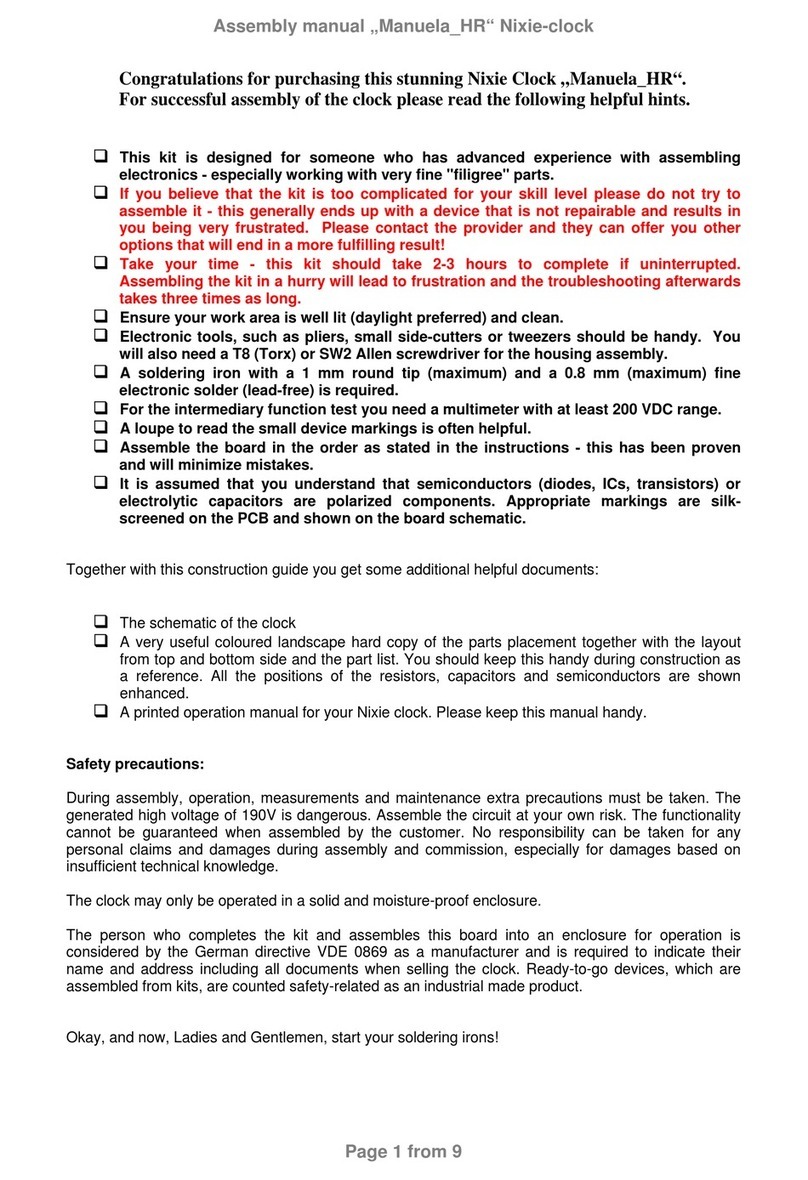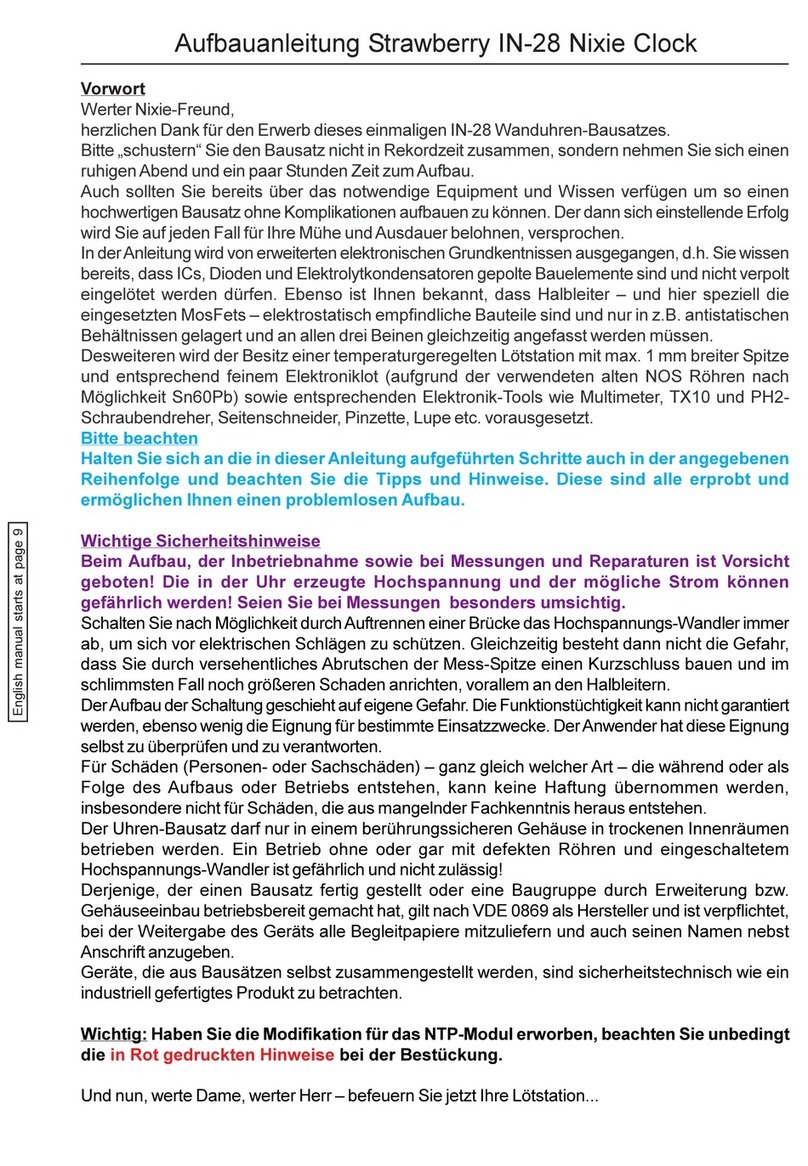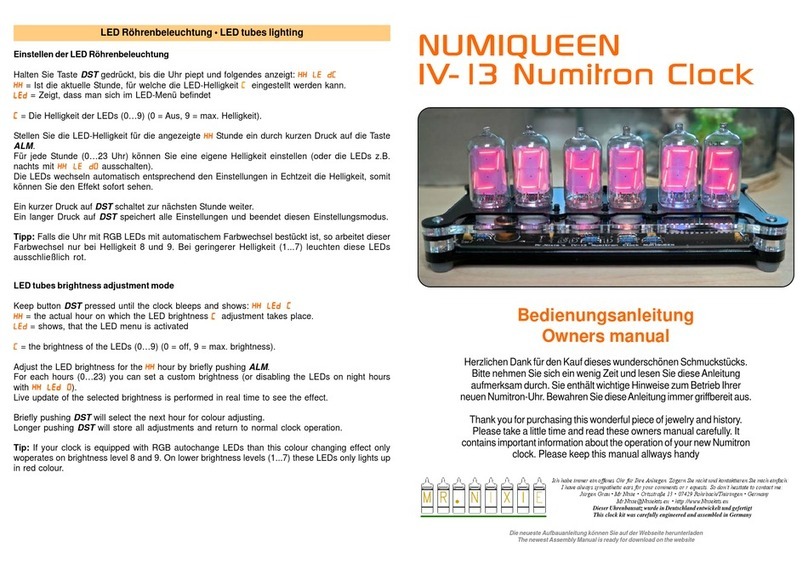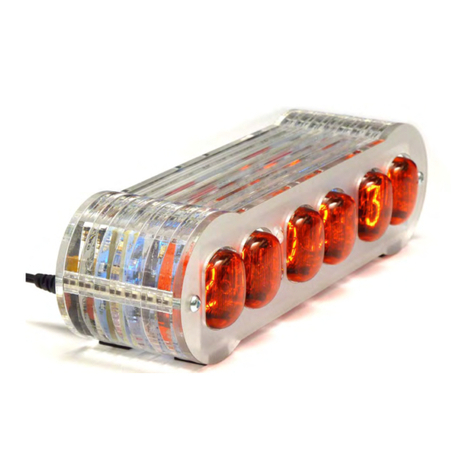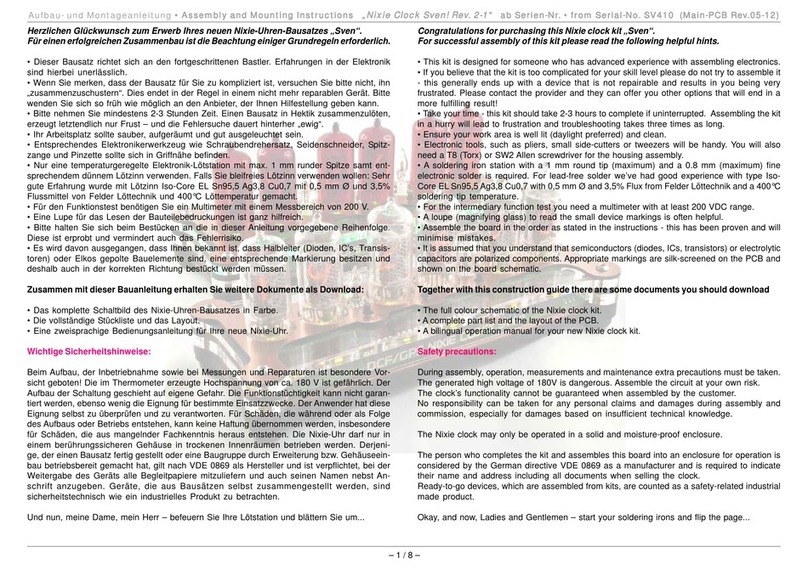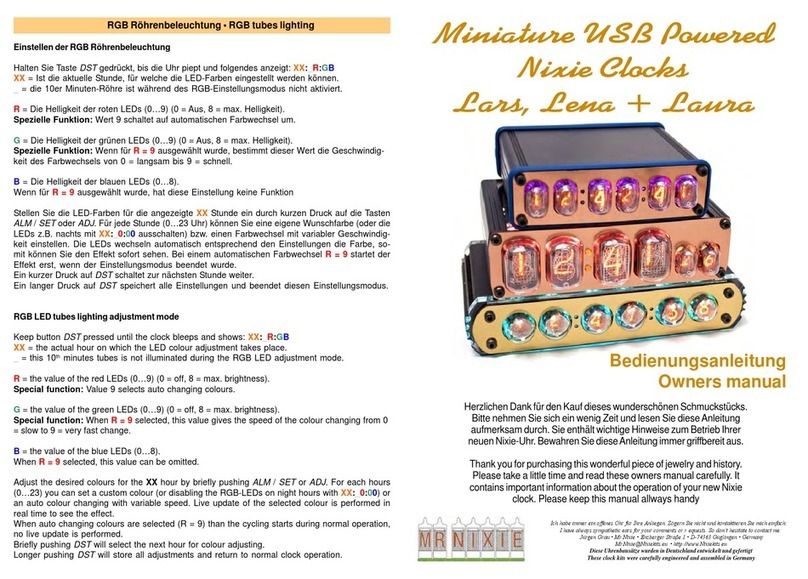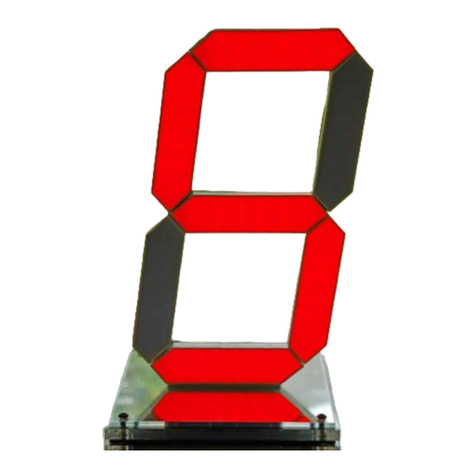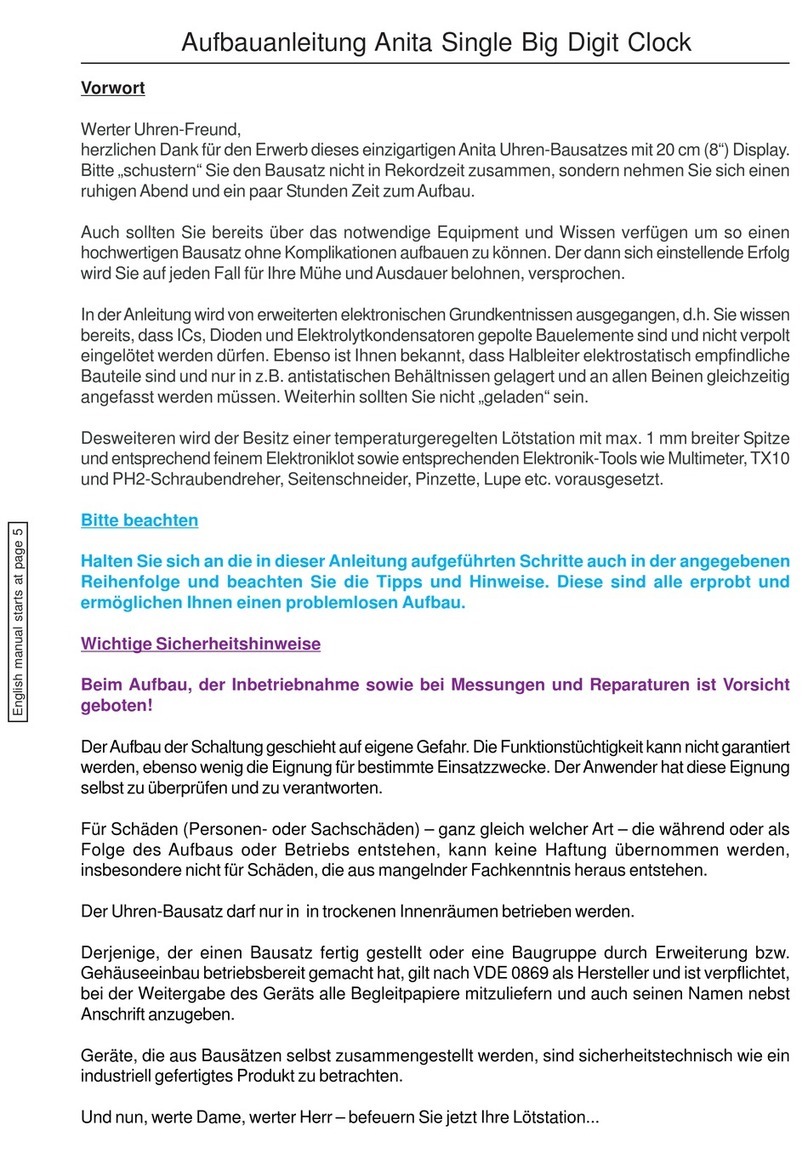
Aufbau- und Montageanleitung IVIV
IVIV
IV-11/15-11/15
-11/15-11/15
-11/15 VFD Uhr „JVFD Uhr „J
VFD Uhr „JVFD Uhr „J
VFD Uhr „Jennenn
ennenn
enny ry r
y ry r
y reloaded“eloaded“
eloaded“eloaded“
eloaded“ Assembly- and Mounting-Instructions IVIV
IVIV
IV-11/15-11/15
-11/15-11/15
-11/15 VFD ClocVFD Cloc
VFD ClocVFD Cloc
VFD Clock „Jk „J
k „Jk „J
k „Jennenn
ennenn
enny ry r
y ry r
y reloaded“eloaded“
eloaded“eloaded“
eloaded“
– 1 –
Herzlichen Glückwunsch zum Erwerb Ihres neuen Uhren-Bausatzes.
Für einen erfolgreichen Zusammenbau sind einige Grundregeln zu beachten.
• Dieser Bausatz richtet sich an den fortgeschrittenen Bastler. Erfahrungen in der Elektronik
sind hierbei unerlässlich.
• Wenn Sie merken, dass der Bausatz für Sie zu kompliziert ist, versuchen Sie bitte nicht, ihn
„zusammenzuschustern“. Dies endet in der Regel in einem nicht mehr reparablen Gerät.
Bitte wenden Sie sich so früh wie möglich an den Anbieter, der Ihnen Hilfestellung geben
kann.
• Bitte nehmen Sie mindestens 3 Stunden Zeit. Einen Bausatz in Hektik zusammenzulöten,
erzeugt letztendlich nur Frust – und die Fehlersuche dauert hinterher „ewig“.
• Ihr Arbeitsplatz sollte sauber, aufgeräumt und gut ausgeleuchtet sein.
• Entsprechendes Elektronikerwerkzeug wie Schraubendrehersatz, Seidenschneider, Spitz-
zange und Pinzette sollte sich in Griffnähe befinden.
• Nur eine temperaturgeregelte Elektronik-Löt station mit max. 1 mm runder S pitze samt
entsprechendem bleifreien dünnem Lötzinn verwenden; sehr gute Erfahrung wurde mit
Lötzinn Iso-Core EL Sn95,5 Ag3,8 Cu0,7 mit 0,5 mm Ø und 3,5% Flussmittel von Felder
Löttechnik und 400°C Löttemperatur gemacht. W ir empfehlen jedoch die V erwendung von
verbleitem Lötzinn.
• Für den Funktionstest benötigen Sie ein Multimeter mit einem Messbereich von 50 V .
• Eine Lupe für das Lesen der Bauteilebedruckungen ist ganz hilfreich.
• Bitte halten Sie sich beim Bestücken an die in dieser Anleitung vorgegebene Reihenfolge.
Diese ist erprobt und vermindert auch das Fehlerrisiko.
• Es wird davon ausgegangen, dass Ihnen bekannt ist, dass Halbleiter (Dioden, IC’s,
Transistoren) oder Elkos gepolte Bauelemente sind, eine entsprechende Markierung be-
sitzen und deshalb auch in der korrekten Richtung bestückt werden müssen.
Zusammen mit dieser Bauanleitung erhalten Sie weitere Dokumente als Download:
• Das komplette Schaltbild des Uhren-Bausatzes in Farbe.
• Die vollständige S tückliste mit Farbcodes der Widerstände.
• Eine zweisprachige Bedienungsanleitung für Ihre neue Uhr .
Wichtige Sicherheitshinweise:
Beim Aufbau, der Inbetriebnahme sowie bei Messungen und Rep araturen ist besondere
Vorsicht geboten! Der Aufbau der Schaltung geschieht auf eigene Gefahr . Die Funktions-
tüchtigkeit kann nicht garantiert werden, ebenso wenig die Eignung für bestimmte Einsatz-
zwecke. Der Anwender hat diese Eignung selbst zu überprüfen und zu verantworten. Für
Schäden, die während oder als Folge des Aufbaus oder Betriebs ent stehen, kann keine
Haftung übernommen werden, insbesondere für Schäden, die aus mangelnder Fach-
kenntnis heraus entstehen. Die Uhr darf nur in einem berührungssicheren Gehäuse in
trockenen Innenräumen betrieben werden.
Derjenige, der einen Bausatz fertig gestellt oder eine Baugruppe durch Erweiterung bzw .
Gehäuseeinbau betriebsbereit gemacht hat, gilt nach VDE 0869 als Hersteller und ist
verpflichtet, bei der Weitergabe des Geräts alle Begleitpapiere mitzuliefern und auch sei-
nen Namen nebst Anschrift anzugeben. Geräte, die aus Bausätzen selbst zusammenge-
stellt werden, sind sicherheitstechnisch wie ein industrielles Produkt zu betrachten.
Und nun, meine Dame, mein Herr – befeuern Sie Ihre Lötstation und blättern Sie um...
Ausgabe1.2 Stand11.12.2012abSerien-Nr.JR-001
Congratulations for purchasing this stunning clock kit.
For successful assembly of this kit please read the following helpful hints.
• This kit is designed for someone who has advanced experience with assembling
electronics.
• If you believe that the kit is too complicated for your skill level please do not try to assemble
it - this generally ends up with a device that is not repairable and results in you being very
frustrated. Please contact the provider and they can offer you other options that will end in a
more fulfilling result!
• Take your time - this kit should t ake 3 hours to complete if uninterrupted. Assembling the
kit in a hurry will lead to frustration and troubleshooting takes three times as long.
• Ensure your work area is well lit (daylight preferred) and clean.
• Electronic tools, such as pliers, small side-cutters or tweezers will be handy . You will also
need a T8 (Torx) or SW2 Allen screwdriver for the housing assembly.
• A soldering iron station with a 1 mm round tip (maximum) and a 0.8 mm (maximum) fine
electronic solder (lead-free) is required. For lead-free solder we’ve had good experience
with type Iso-Core EL Sn95,5 Ag3,8 Cu0,7 with 0,5 mm Ø and 3,5% Flux from Felder
Löttechnik and a 400°C soldering tip temperature; but we highly recommend to use leaded
solder tin.
• For the intermediary function test you need a multimeter with at least 50 VDC range.
• A loupe (magnifying glass) to read the small device markings is of ten helpful.
• Assemble the board in the order as st ated in the instructions - this has been proven and
will minimise mistakes.
• It is assumed that you understand that semiconductors (diodes, ICs, transistors) or
electrolytic capacitors are polarized component s. Appropriate markings are silk-screened
on the PCB and shown on the board schematic.
Together with this construction guide there are some documents you should download
• The full colour schematic of the clock kit.
• A complete part list with the colour coding of the resistors.
• A bilingual operation manual for your new clock kit.
Safety precautions:
During assembly, operation, measurement s and maintenance extra precautions must be
taken. Assemble the circuit at your own risk. The clock’s functionality cannot be guaranteed
when assembled by the customer .
No responsibility can be taken for any personal claims and damages during assembly and
commission, especially for damages based on insufficient technical knowledge.
The clock may only be operated in a solid and moisture-proof enclosure.
The person who completes the kit and assembles this board into an enclosure for operation
is considered by the German directive VDE 0869 as a manufacturer and is required to
indicate their name and address including all documents when selling the clock.
Ready-to-go devices, which are assembled from kits, are counted as a safety-related
industrial made product.
Okay, and now, Ladies and Gentlemen – st art your soldering irons and flip the p age...
Issue1.2 from12/11/2012validfrom serialno. JR-001
